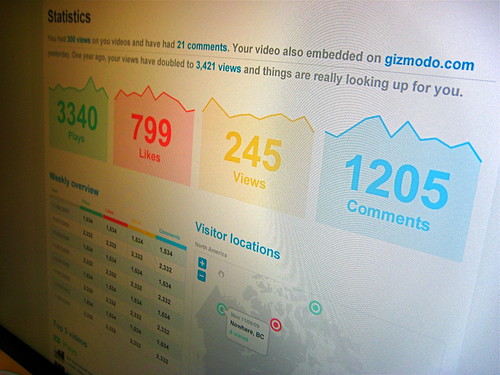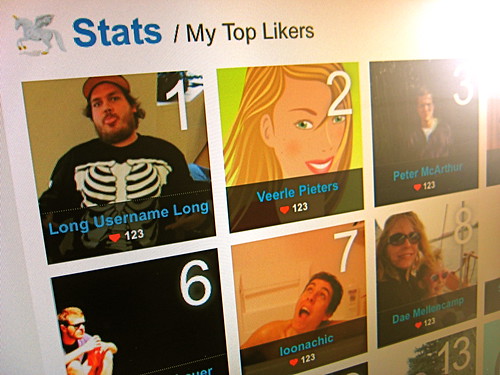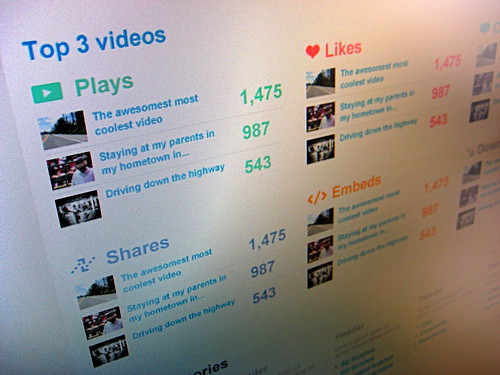
Chrome OS
http://googleblog.blogspot.com/2009/07/introducing-google-chrome-os.html
Google already competes with Microsoft in search, productivity software, and with its Chrome browser, launched in 2008. But in July the company announced a direct assault on Redmond's core product, the Windows operating system. In the second half of 2010, Google intends to release the Chrome OS, which it describes as a lighter, speedier operating system tailored to running Web-based applications. The software will be free to download, but the company may charge PC makers a fee to bundle it with new products.
read the story'); document.write('post a comment'); document.write(''); } // ]]>
Jumat, 09 Oktober 2009
Google's 20 Hottest Tools: Chrome OS - BusinessWeek
Google Wave Is Easier To Understand Than…
As we’ve noted several times, Google Wave
is a service that is fairly hard to explain. And for many people, it’s also hard to understand. That seems somewhat reasonable given that it’s trying to be a new form of communication and that it is still very early in its life span. But just how hard is it to understand? A new website brilliantly takes a look.
Easiertounderstandthanwave.com
pits Wave against the other hard-to-understand aspects of life. On the site, you are given a picture of Wave and a picture of something else and asked to click on which is easier to understand. Wave’s competition includes: Metaphysics, the end of Donnie Darko, Ozzy Osbourne, Death, osmotic pressure, cardiothoracic surgery, the health care-reform bill, Google Fast Flip, and even Sarah Palin.
Humorously, Google Wave loses to all of those. As of right now, it is beating very few topics. They include: Women, Scientology, the United States Tax code, Chinese telegraph code, Microsoft Visio 2004, and Obama’s Nobel Peace Prize.
Users are welcome to submit other topics to put up again Wave in the competition. But the best part of the site has to be the elevator music-version of Avril Lavigne’s “Complicated” playing in a loop in the background.
Update: Here’s another awesome tidbit about the site. I have it on very good authority that it was built by a Facebook employee. It’s not clear if this was just one employee acting alone, or if Easiertounderstandthanwave.com can be viewed as how Facebook looks at Google Wave. Which is to say, down on it.
And now we know why we have the little “Not affiliated with any company” at the bottom.
Update 2: Okay, it was just one employee. Conspiracy theorists can rest easy. Maybe.
Company: Website: wave.google.com Launch Date: May 28, 2009 Google Wave is a tool for communication and collaboration on the web, launching in the second half of 2009.
In Google Wave, users create and invite other people to “waves”. Everyone on a wave can use richly formatted text, photos, gadgets, and… Learn More
Information provided by CrunchBase
Social Media Cannot Deliver Business Value If Employees Are Denied Access
A survey of 1,400 CIOs in the US published by Robert Half Technology (see press release) shows some interesting – and indeed worrying – results about the number of enterprises that prevent their employees from accessing social media sites from the workplace.
Here are the results:
CIOs were asked, “Which of the following most closely describes your company’s policy on visiting social networking sites, such as Facebook, MySpace and Twitter, while at work?” Their responses:
Prohibited completely 54%
Permitted for business purposes only 19%
Permitted for limited personal use 16%
Permitted for any type of personal use 10%
Honestly, I find these numbers quite appalling. I do appreciate that security and productivity concerns are still dominant, but I suspect this is directly connected to a limited understanding of how social media can deliver value and the mechanisms to get there.
It is clearly easier to block access than put the onus of assessing employee performances on managers. For sure there will be employees whose productivity drops due to social media use, but there will be others – and presumably many more – who will be able to leverage social media in ways that make their work more effective, more productive and – last but not least – more fun.
I am pretty sure that some of these same enterprises have their own web 2.0 plans where they aim at engaging both employees and customers through social networks that they build themselves, on their turf, under their control. But isn’t this a recipe for failure? Haven’t corporations and government agencies understood that social networks are a bottom-up. peer-to-peer, grass-root phenomenon that cannot be planned or engineered by a formal organization? How long will it take before they understand that only blurring personal and work boundaries will unleash the value they are desperately seeking (and yet denying) in social media?
Although I cover social media in government, I start to believe that most of the advice I give my clients equally applies to private sector organizations. A few months ago I wrote two posts about whether governments should use consumer tools for social networking, and looked at how codes of conduct for the use of social policies are easier than many think. I’ve also come across multiple cases where consumer social media are already mission-critical for some organizations, as decision makers do use their connections on Linked, Facebook and the likes to actually do business. I have also coined the term employee-centric government to indicate that key to unlock the benefits of web 2.0 is to understand its peer-to-peer nature (see my latest post on this).
For Gartner clients, there is a wealth of resources on strategies and tactics to support the use of social media at work, to establish frameworks to guide employees through finding business value in those media, and to identify and manage the security and reputational risks they pose. My colleague Anthony Bradley has just provided links to some of this research and suggested blog readers to take a quick survey to compare results. An additional piece of research that may be useful (available to clients or for a fee) is one describing the Gartner SOCIAL framework , which suggests a six step approach to value realization, i.e. Seek, Observe, Complement, Involve, Assess and Leverage)
Staying in denial and closing the fences is not an option. Whether to attract the best employees, or to make them more effective and productive, whether to stay closer to their customers and suppliers, whether to sense emerging needs and trends, enterprises in all sectors will have to let their staff join social media. Of course this won’t be a free ticket to waste time on browsing family pictures or arranging dinners with friends. But the boundaries between personal and professional use will blur forever, and the ability to assess, identify and nurture business value from social media will become a critical capability for enterprises (and their managers) in all industry sectors.
Kamis, 08 Oktober 2009
What's new on Vimeo! on Vimeo Staff Blog
Andrew Pile October 2nd, 2009We always try to be as transparent as possible here at Vimeo, so from time to time we like to give you guys a solid update on what we're cooking up. On the menu soon are a few BIG projects that we're very excited about and we think you're going to like them.
Desktop Uploader
You've been asking for it for years, and now it's coming: the Desktop Uploader is a fancy new way to upload your videos without ever launching your web browser. This should be perfect for those of you who sometimes have trouble uploading, and for folks who would like to batch upload a bunch of videos at once. Features include:
• More-stable uploading (no more frustrating browser time-outs!)
• Pause/resume features (Start. Stop. Get a sandwich. Start again. NBD.)
• Upload multiple videos at once (Up to 10 at once!)
• Edit titles, tags, and descriptions (more controls coming in future updates)
• Available for Windows, Macs, and Linux (it uses Adobe AIR)The uploader will be in public beta soon, but you can get special access now by asking for it here.
Advanced Stats
As many of you know, we've been working hard on a new stats feature. It's taken us a while because we want to get it right, and so far it's looking great. The majority of the features will be for Plus users with a few key stats available for Basic members as well, so everyone can join in on the fun. Feature highlights:
• Extensive data on all videos in aggregate and individually
• Daily breakdowns of likes, plays, comments, HD vs SD plays, loads and finishes
• Awesome referrer data (where are your videos being watched?)
• Share and download stats (find out what video people download the most)
• Geo stats (see where people are watching your stuff)
• And more...We'll be releasing advanced stats before the end of the year, but for now here's a preview:
* NOTE: We're tweaking these views a lot so what you see will change before it's done.
Larger videos
If you haven't noticed already, the video pages are now larger. For most videos they are 640x480! That means your SD videos are bigger and better than ever. And more often than not, your videos will play in their native resolution. For an example, just check out this video.
Featured Groups and Channels!
Looking for some inspiration? Check out these Groups and Channels we've been watching:
The Pictures Don't Move
Sometimes the best videos are ones where not a lot happens. Great for photographers or anyone else looking to celebrate the simple and beautiful side of capturing video, The Pictures Don't Move is a fantastic Group that celebrates the pure experience of capturing life on video.FilmTools: How To
Not everyone has a couple grand to drop on the latest and greatest film accessories. We sure don't. Film Tools is perfect for you guys to share your DIY skills with step-by-step instructions for making all those fancy new toys everyone seems to be using. Learn how to make lend adapters, steadicams, glide tracks, and all sorts of other cool equipment.Corkscrew Bootlegs
"Produced coaster videos are OK but, they fall short when you want to get an actual feel for the ride. This channel is dedicated to the true coaster video, when the rider sneaks a camera on board, straps in and hits record." Couldn't have said it better myself.Enjoy the week, and as always, have fun and be creative!
Google, Microsoft In Search Engine Talks With Twitter? - Software - IT Channel News by CRN
-->
--> --> --> --> Twitter may have finally found a way to monetize the billions of "tweets" its users send, thanks to potential agreements under which the social networking site would license Google and Microsoft (NSDQ:MSFT) to integrate those tweets in their search engines.Microsoft and Google are reportedly in advanced negotiations with Twitter to license that company's live tweet feeds on a real-time basis, according to a Thursday report in The Wall Street Journal's All Things Digital blog, which can be read by clicking here.
And because of Yahoo's recent agreement to partner with Microsoft on search engines, Yahoo (NSDQ:YHOO) could potentially take advantage of any Microsoft agreement with Twitter, wrote Kara Swisher in the blog post.
While Twitter has its own search engine, it is currently not tied to other search engines. Swisher wrote that Twitter would be hard-pressed to expand its search capabilities to compete with Microsoft or Google.
It also is possible that neither Microsoft nor Google would finalize an agreement with Twitter, Swisher also wrote.
Such an agreement could have huge implications for the ability of Google (NSDQ:GOOG) and Microsoft to expand their search engine capabilities. Getting an exact number of how many tweets are generated per day or per month is difficult, but Twitter is certainly one of the most heavily-visited sites on the Internet.
Complete, an online media company measuring online consumer behavior, ranked Twitter as the 38th-most visit site August 2009, with an estimated 23.6 million visits, up about 803 percent over August 2008.
While much of the information that is sent via the 140-character tweets is mundane, Twitter users are also quick to tweet about events as they happen. This includes events spanning everything from major breaking news, such as a riot or flood, to breaking product or company news, making the real-time Twitter feed valuable to Microsoft or Google search engines.
However, even the mundane items, if data is mined properly, are valuable to search engines. Marketers, for instance, could use the Twitter feeds to check the status of a marketing campaign, or gain a sense of what Twitter users think about an event.
Selasa, 06 Oktober 2009
HOW TO: Integrate Facebook With Your Blog
Love it, hate it, or mildly tolerate it, you can’t dismiss Facebook’s massive success. Even in markets where it doesn’t dominate the social web, Facebook is catching up and will likely succeed.
It’s easy to forget sometimes that there was an Internet before Facebook (
) and many of us have existing blogs or websites. Integrating with Facebook is a great way to get additional exposure for your content, whether you re-publish your blog content directly on Facebook, or you use something like Facebook Connect to add the Facebook login/profile experience to your own site.
Here are some great ways to integrate your website or blog with Facebook.
Custom CMS or XHTML site

Although using something like WordPress (
) to power a site or blog is becoming increasingly common, many people have sites using either a custom CMS or something coded in XHTML/PHP (
), Ruby, Django, etc.
If you fall into this category, the Facebook Developer Wiki is a great source of information.
Even better, last week, Facebook introduced the Facebook Connect Wizard and Facebook Connect Playground that makes implementing Facebook Connect into your site easier, and also offers up sample code and widgets for comment boxes, Facebook Connect buttons, and more.
WordPress

WordPress is undoubtedly one of the most popular publishing platforms out there. Given WordPress’s vibrant community, you’d think that integrating Facebook into your WordPress site would be a breeze.
Well, it is and it isn’t. There are a number of plugins available but getting everything set-up can still be a bit complicated. Never fear, here are some great resources and tools for integrating your WordPress blog with your Facebook page:
WP-FBConnect — This plugin was started by Facebook engineer Adam Hupp. Although it hasn’t been updated as much as some of the other options, it does offer a way to integrate Facebook Connect with WordPress. This way, users can use their Facebook login to leave comments (and have them published to their feed) and have their Facebook avatar show up (with a Facebook designation) on your site. Check out Adam Breckler’s excellent tutorial for more help with this plugin.
Sociable Facebook Connect — Sociable.es has a Facebook Connect plugin too and it is frequently updated and offers other features, like the ability to add a box displaying recent visitors, commenters and friends. Be aware that the Sociable plugin will create a new user for your Facebook Connect users on your blog (this isn’t always ideal).
WPBook — WPBook does a few unique things, first, it lets you cross-post all of your blog content onto Facebook (which is great if you don’t already have that set-up). Second, it makes sure that comments published on one entry show up on the other. So if you have comments on both your Facebook Note and on your regular blog entry, everyone can see the comments at both places. This is great for users who want to get their content out to more people, but don’t want to deal with trying to track down a lot of separate conversations.
Add Your Blog Feed — If you don’t care so much about comments, but just want your blog content to show up on Facebook, you can follow Six Apart’s excellent guide to adding your external blog feed. It’s intended for TypePad (
) users, but good reading for anyone using a blogging platform with RSS support.
I would be remiss if I didn’t point out Tim Marsh’s excellent Dummies Guide to Integrating Facebook into WordPress. I ran across this in my research and was impressed with the level of thought and care that went into the post. Tim also released a free 40-page eBook (PDF link) that you can download with even more information.
Movable Type/TypePad

Six Apart has two blogging platforms, the self-hosted MovableType and the hosted TypePad. Last December, Six Apart released the Facebook Connect Commenters plugin for Movable Type. This will let users log in with their Facebook credentials, leave a comment, and then share those actions on Facebook (so comments show-up in mini-feeds, etc.).
On the TypePad side, they’ve built Facebook compatibility into the newest release (and are taking it even further with TypePad Motion) — letting you post to your blog from Facebook, show your updates on Facebook, and let users comment using Facebook or Twitter IDs.
Drupal and Joomla
Drupal (
) and Joomla (
) are two of the more popular open source content management systems. Both offer lots of robust features that are especially useful for large sites and communities.
Drupal in particular is often used when creating larger community sites. Because many of these sites might already have existing user profiles or logins, adding Facebook connectivity can be attractive for users — because who wants to sign up for another account — and for site owners who want to build a broader and more robust community.
There are a number of Facebook plugins for Drupal, but these are a few of my favorites:
Drupal for Facebook is really interesting because it isn’t just about letting users login with Facebook credentials (which it can do), but about using the power of Drupal to create Facebook applications and to push Drupal-site content out to Facebook. The project has been around for more than two years and is actively developed.
Drupal Facebook Connect is a module that plugs in Facebook Connect logins into an existing Drupal site. That way, users can login with their Facebook profile, see what Facebook friends also have an account on that Drupal site and publish customizable content back to their Facebook feed. Users can also invite Facebook friends to join the Drupal site. This is very cool for anyone who has a web-app based in Drupal.
Drupal Facebook Connect Module is another option for Drupal users that want to add Facebook Connect logins to their existing site.
On the Joomla front, jwFacebook Comments 1.5 allows site-owners to add a Facebook comment box to the bottom of Joomla entries.
Comment Systems

If your primary focus is just letting users leave comments using their Facebook login, you might want to look at some of the third-party commenting systems that integrate with a variety of platforms and sites.
) is our commenting system of choice. Disqus added Facebook Connect support last December and you can link your Facebook and Disqus profiles together. Disqus also lets users log in with Twitter (
) credentials.
Similarly, JS-Kit’s Echo system lets you log in with a number of different identities and also choose where you want your comment published (on the site and to your Facebook friends, to your Twitter followers, etc.).
Third-party commenting systems like Disqus and Echo, which take some of the stress and mess of OpenID and Facebook Connect out of the equation, can do a lot to encourage more people to comment on your site.
Share on Facebook
You know that awesome “Share on Facebook” button we feature here at Mashable (
)? You can get your own here, and there is even an easy plugin for WordPress users.
So site owners — how do you integrate Facebook with your blogs and sites? What are some of the best practices you can offer to others? Did we miss your favorite plugin or tool? Let us know in the comments!
More Facebook resources from Mashable:
- HOW TO: Use Facebook for Professional Networking
- 5 Tips for Optimizing Your Brand’s Facebook Presence
- The Journalist’s Guide to Facebook
- Facebook Pages vs Facebook Groups: What’s the Difference?
- HOW TO: Build Your Personal Brand on Facebook









